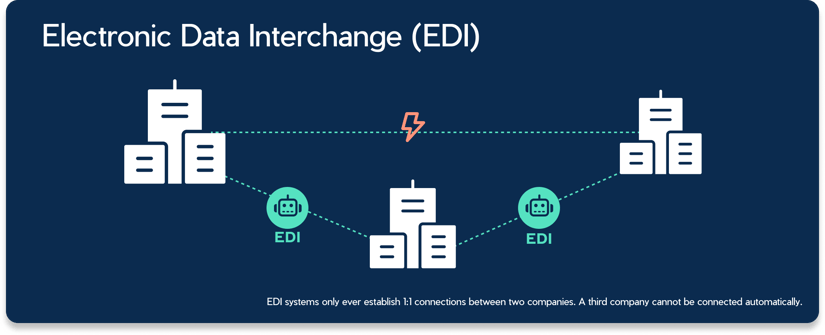EDI is a revolutionary concept that enables the automated processing of order documents and the exchange of business documents in a standard electronic format between organisations.
Imagine a world where the need for mail, fax and email for document routing is eliminated and instead seamless routing from one application to another for instant processing across organisational boundaries is possible.
This article will highlight the benefits and challenges of the EDI system, revolutionising the way business partners communicate with each other and helping to streamline processes and focus on more important tasks. We will also discuss the prerequisites for utilising EDI transmission and the potential hurdles that can come with implementation. Immerse yourself in the fascinating world of EDI, an indispensable tool for modern business processes.
What is EDI technology?
With the introduction of electronic data interchange (EDI), the automated processing of order documents can become a reality. EDI enables the digital exchange of business documents between companies in a standardised electronic format. By eliminating the need for post, fax and e-mail, documents can be seamlessly transferred from one application to another for immediate processing across company boundaries.
This automation not only saves time, but also reduces the risk of errors that can occur during manual data entry. By utilising EDI processes, companies can streamline their operations and focus on more important tasks at hand.
How does EDI technology work in document processing?
In order to use EDI transmission, point-to-point connections must be established between two business partners. The companies involved must agree on a specific EDI standard and a specific version when setting up the direct connections for the exchange of EDI messages. All EDI messages sent and received must then comply with this agreed standard format so that error-free processing is possible in the systems of both business partners.

The advantages of EDI in document processing
The benefits of using EDI for automated document processing are numerous. It not only simplifies and speeds up business processes, but also increases data accuracy and improves overall efficiency. Standard EDI formats ensure data quality and proper process management. The direct connection of the other company to your own ERP systems via EDI is particularly useful for business partners with high trading volumes.
The disadvantages of EDI in document processing
The disadvantage of EDI is the high level of effort required for each individual EDI connection. A standardised format must be agreed with the business partner for each connection, which often requires a great deal of coordination. In addition to the initial agreement, the format must also be adapted individually each time one of the two partners changes the formatting or the structure of a data field.
In addition to the high time and cost involved in harmonising the format, additional software costs for process integration solutions are typically required to set up the EDI connection. Furthermore, the EDI connection does not protect against one business partner transmitting invalid order data that runs into errors in the other business partner's ERP system and requires human verification.
The advantages and disadvantages, in a nutshell:
Advantages of EDI technology:
- Accelerated document processing
- Time savings through automation
- Reduced risk of errors
- More efficient business processes
- Improved data quality and efficiency
Disadvantages of EDI technology:
- Complex set-up and coordination
- High customisation requirements
- Additional software costs
- Risk of data transfer errors
- Not always advantageous for smaller customers
Conclusion
To summarise, EDI has become an indispensable tool in the way key business partners communicate with each other. Especially for business partners who exchange high volumes of trade, the direct digital exchange of information can help to automate order entry.
Due to the high level of coordination and costs involved, an EDI connection is often not worthwhile for customers who order irregularly or only very small baskets of goods.

%201.jpg)
